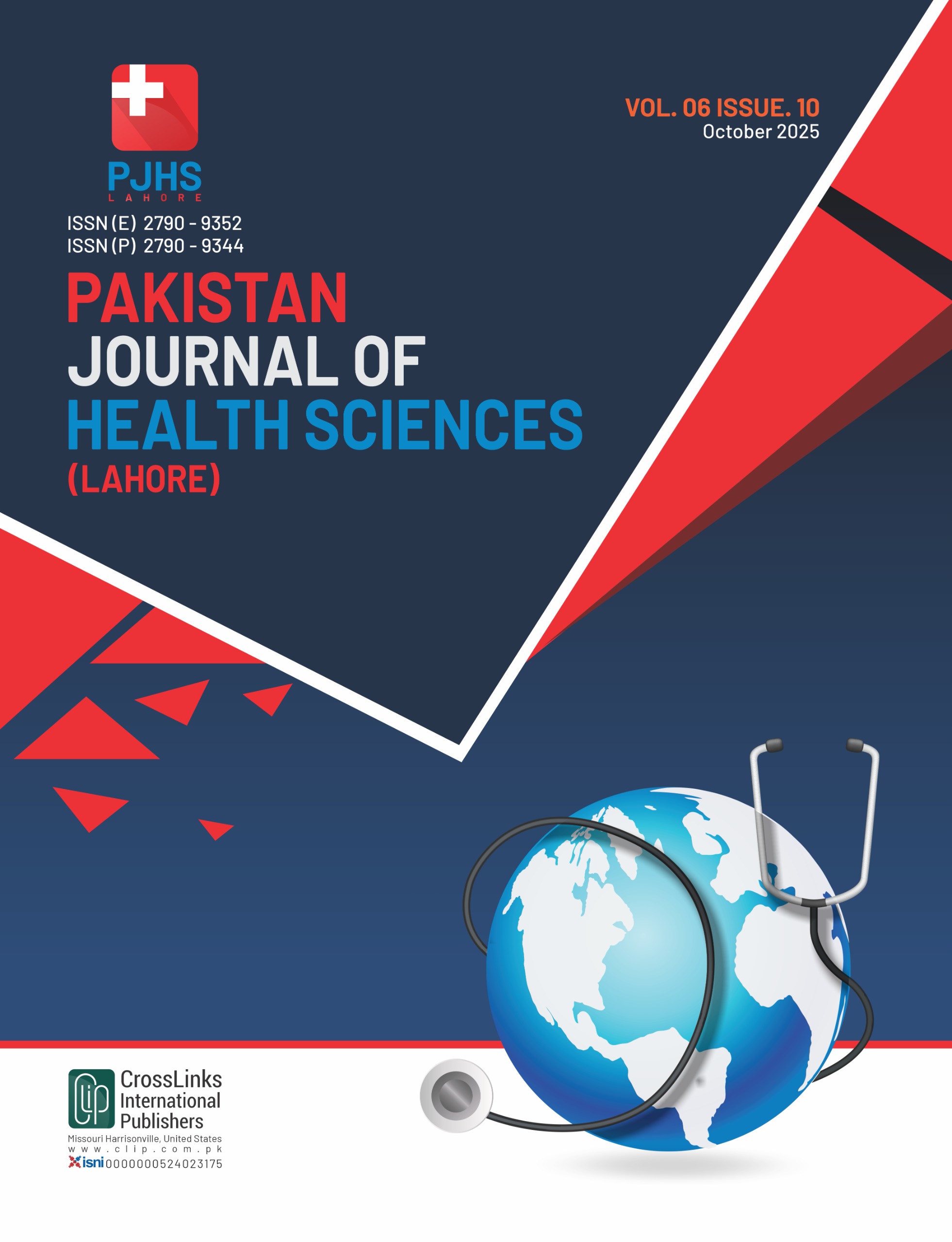Frequency of Hypothyroidism and Subclinical Hypothyroidism in Females with Secondary Infertility Presenting at a Tertiary Care Hospital
Hypothyroidism and Subclinical Hypothyroidism in Females with Secondary Infertility
DOI:
https://doi.org/10.54393/pjhs.v6i10.3234Keywords:
Secondary Infertility, Hypothyroidism, Subclinical Hypothyroidism, Thyroid Dysfunction, Reproductive Health, Thyroid ScreeningAbstract
Hypothyroidism, particularly subclinical hypothyroidism (SCH), is a frequent endocrine disorder linked to reproductive dysfunction, including secondary infertility. In Pakistan, where infertility rates are rising, understanding the prevalence and impact of thyroid dysfunction among women with secondary infertility is critical for improving fertility management. Objectives: To investigate the correlation between secondary infertility and subclinical hypothyroidism among Pakistani women. Methods: A cross-sectional descriptive study was conducted on 130 women aged 20–40 years presenting with secondary infertility at a tertiary care hospital in Pakistan. Participants underwent clinical assessment, including measurement of thyroid-stimulating hormone (TSH), free triiodothyronine (FT3), and free thyroxine (FT4) levels. SCH was defined as TSH between 4.5 and 20 mIU/L with normal FT3 and FT4. Data on demographic variables, parity, and duration of infertility were collected. Statistical analysis involved chi-square tests to examine associations between hypothyroidism and demographic/clinical factors. Results: Hypothyroidism was identified in 28.5% of participants, comprising 20.8% with subclinical and 7.7% with overt hypothyroidism. The highest prevalence of subclinical hypothyroidism was observed among women aged 31–40 years (28.6%) and those with BMI ≥25 kg/m² (21.1%). However, it revealed no statistically significant associations between hypothyroidism and age (p=0.256), BMI (p=0.827), parity (p=1.000), or duration of infertility (p=1.000). Conclusions: Thyroid dysfunction, particularly subclinical hypothyroidism, is highly prevalent in women with secondary infertility, despite the absence of significant associations with common demographic or reproductive variables. These findings support routine thyroid screening as an essential component of infertility assessment.
References
Moazzam H, Rehman S, Iqbal S, Khan GM, Sohail I, Saddiqa I. Comparison of Thyroid Hormone Profile (T3, T4, TSH, ANTI TPOAB, & TBG) Among Fertile and Infertile Females. The Professional Medical Journal. 2023 Jan; 30(02): 258-63. doi: 10.29309/TPMJ/2023.30.02.7317. DOI: https://doi.org/10.29309/TPMJ/2023.30.02.7317
Jabeen F, Khadija S, Daud S. Prevalence of Primary and Secondary Infertility. Saudi Journal of Medicine. 2022 Jan; 7(1): 22-8. doi: 10.36348/sjm.2022.v07i01.004. DOI: https://doi.org/10.36348/sjm.2022.v07i01.004
Hussain S, Naveed S, Mujeeb N, Tariq S. Management and Treatment Protocols in Sociology of Gender: Role of Thyroid Hormone Dysfunctioning in Infertility. Journal of Asian Development Studies. 2023 Sep; 12(3): 1105-13.
Poppe K. Management of Endocrine Disease: Thyroid and Female Infertility: More Questions Than Answers? European Journal of Endocrinology. 2021 Apr; 184(4): R123-35. doi: 10.1530/EJE-20-1284. DOI: https://doi.org/10.1530/EJE-20-1284
Tańska K, Gietka-Czernel M, Glinicki P, Kozakowski J. Thyroid Autoimmunity and Its Negative Impact on Female Fertility and Maternal Pregnancy Outcomes. Frontiers in Endocrinology. 2023 Jan; 13: 1049665. doi: 10.3389/fendo.2022.1049665. DOI: https://doi.org/10.3389/fendo.2022.1049665
Fatima W, Akhtar AM, Hanif A, Gilani A, Farooq SM. Sociodemographics and Risk Factors of Secondary Infertility in Pakistan: A Case-Control Study. Journal of Hunan University Natural Sciences. 2023; 50(10). doi: 10.55463/issn.1674-2974.50.10.22. DOI: https://doi.org/10.55463/issn.1674-2974.50.10.22
Saba N, Rashid S, Ayub H, Khan RI. Association of Hyperprolactinemia in Females with Infertility. Indus Journal of Bioscience Research. 2025 Jan; 3(1): 314-9. doi: 10.70749/ijbr.v3i1.488. DOI: https://doi.org/10.70749/ijbr.v3i1.488
Dardar H, Abdulla S, Abdulrazeg A, Elhddad A. Association of BMI and Hormonal Imbalance with Primary and Secondary Infertility: A Cross-Sectional Study. AlQalam Journal of Medical and Applied Sciences. 2022 Dec: 565-72.
Ateeb M, Asif M, ul Haq I, Nazar MS, Junaid M, Zakki SA. Prevalence and Determinants of Female Infertility in Rahim Yar Khan, Pakistan: A Case-Control Study. Reyazuddin Research and Development Society Journal of Pharmacy and Allied Health Sciences. 2023 Jul; 1(2): 39-51. doi: 10.37962/jphs.v1i2.50. DOI: https://doi.org/10.37962/jphs.v1i2.50
Mansourian HR. Adverse Effects of Hypothyroidism on Fertility and Pregnancy: A Mini Review. Medical Laboratory Journal. 2022 Jan; 16(4). doi: 10.52547/mlj.16.4.1. DOI: https://doi.org/10.52547/mlj.16.4.1
Ahtamovna ZZ. Secondary Infertility in Women of Reproductive Age with Hypothyroidism. ACADEMICIA: An International Multidisciplinary Research Journal. 2022; 12(5): 649-53. doi: 10.5958/2249-7137.2022.00424.4. DOI: https://doi.org/10.5958/2249-7137.2022.00424.4
Birjandi B, Ramezani Tehrani F, Amouzegar A, Tohidi M, Bidhendi Yarandi R, Azizi F. The Association Between Subclinical Hypothyroidism and TPOAB Positivity with Infertility in A Population-Based Study: Tehran Thyroid Study (TTS). BMC Endocrine Disorders. 2021 May; 21(1): 108. doi: 10.1186/s12902-021-00773-y. DOI: https://doi.org/10.1186/s12902-021-00773-y
Jagun OE, Andu BA, Olawale OO. Subclinical Hypothyroidism Among Infertile Women at A Tertiary Hospital in South-West Nigeria. African Health Sciences. 2022 Aug; 22(2): 444-50. doi: 10.4314/ahs.v22i2.51. DOI: https://doi.org/10.4314/ahs.v22i2.51
Bucci I, Giuliani C, Di Dalmazi G, Formoso G, Napolitano G. Thyroid Autoimmunity in Female Infertility and Assisted Reproductive Technology Outcome. Frontiers in Endocrinology. 2022 May; 13: 768363. doi: 10.3389/fendo.2022.768363. DOI: https://doi.org/10.3389/fendo.2022.768363
Akande AA, Isah IA, Aliyu IS, Adesiyun AG. Thyroid Dysfunction in Women of Reproductive Age: Laboratory Protocol for Infertility Evaluation. Annals of Ibadan Postgraduate Medicine. 2022; 20(1): 53-7.
Aghayeva S, Sonmezer M, Şükür YE, Jafarzade A. The role of Thyroid Hormones, Vitamins, and Microelements in Female Infertility. Revista Brasileira de Ginecologia e Obstetrícia/RBGO Gynecology and Obstetrics. 2023 Nov; 45(11): e683-8. doi: 10.1055/s-0043-1772478. DOI: https://doi.org/10.1055/s-0043-1772478
Panahandeh F, Feizi F, Pourghasem M, Khafri S, Abedian Z, Pourghasem K et al. Hypothyroidism and Fertility: An Animal Model Follows Up in the Second-Generation. Cell Journal (Yakhteh). 2022 Mar; 24(3): 148.
Zhang Y, Wu W, Liu Y, Wang X, Guan Y, Jia L. Analysis of Basal Serum TSH, FT3, and FT4 Levels Based On Age, Sampling Time in Women with Infertility. BioMed Central Women's Health. 2021 Aug; 21(1): 317. doi: 10.1186/s12905-021-01453-8. DOI: https://doi.org/10.1186/s12905-021-01453-8
Mazzilli R, Medenica S, Di Tommaso AM, Fabozzi G, Zamponi V, Cimadomo D et al. The Role of Thyroid Function in Female and Male Infertility: A Narrative Review. Journal of Endocrinological Investigation. 2023 Jan; 46(1): 15-26. doi: 10.1007/s40618-022-01883-7. DOI: https://doi.org/10.1007/s40618-022-01883-7
Unuane D and Velkeniers B. Impact of Thyroid Disease on Fertility and Assisted Conception. Best Practice and Research Clinical Endocrinology and Metabolism. 2020 Jul; 34(4): 101378. doi: 10.1016/j.beem.2020.101378. DOI: https://doi.org/10.1016/j.beem.2020.101378
Downloads
Published
How to Cite
Issue
Section
License
Copyright (c) 2025 Pakistan Journal of Health Sciences

This work is licensed under a Creative Commons Attribution 4.0 International License.
This is an open-access journal and all the published articles / items are distributed under the terms of the Creative Commons Attribution License, which permits unrestricted use, distribution, and reproduction in any medium, provided the original author and source are credited. For comments













